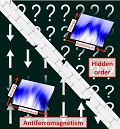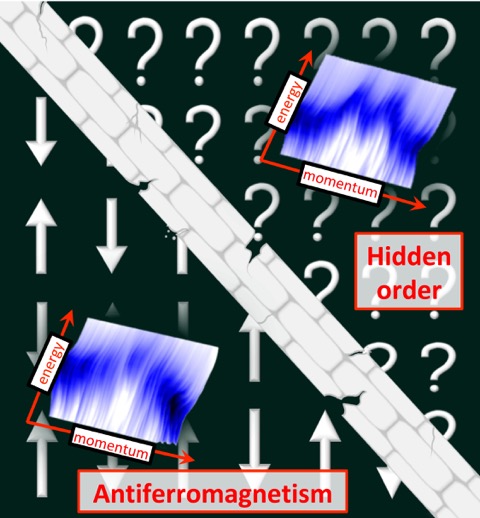Accueil > À la une > In search of hidden order
In search of hidden order
par - 4 juillet 2021

All changes of state in matter, like the freezing of water into ice, are characterized by some physical parameter of the system becoming ordered. But in some exceptional cases, the parameter describing the ordered state remains unknown, hiding new physics. Now, an international collaboration led by researchers at ISMO has unveiled how, in one of such mysterious “hidden-order” phases, the interactions between quantum electronic transform under the effect of chemical pressure. This finding sheds new light into what physics is cloaked behind the “hidden-order” veil.
A structural phase transition is characterized by an atomic displacement, a gas-liquid phase transition by the difference of their densities, a ferromagnetic transition by a net magnetization and a superconducting transition by a macroscopic electronic wave function that indicates the density of Cooper pairs. But in some exceptional cases the parameter describing the ordered phase remains unidentified. These challenging phase transitions usually hide exciting new physics.
In condensed matter physics, the textbook example of a spontaneous transition with an unknown order parameter is the second order transition of URu2Si2 into a mysterious ordered phase below 17.5 K. Despite 40 years of research and decades of proposed theoretical models, there is no consensus on the nature of the ordered parameter and of the ordered phase itself. In other words, we know that a physical quantity is becoming ordered in comparison to the high temperature phase, but we are ignorant of both its nature and of the reason behind it. The corresponding phase is known as “the hidden order phase” and the associated challenge of its identification has earned the sobriquet of “the Higgs boson of condensed matter physics”.
Above a critical applied pressure, the hidden order phase (top right) transits into an antiferromagnetic phase (bottom left) of well-known antiferromagnetic order parameter : neighboring electron spins align in an anti-parallel configuration. Thus, a comparison of the quantum electronic states of the two phases could shed new light into the nature of the hidden order. This is however a very challenging task since experiments directly measuring the electronic states, such as angle-resolved photoemission spectroscopy (ARPES), cannot be employed under pressure. Now, taking advantage of the chemical pressure induced by the partial substitution of Ru with Fe, we could directly probe for the first time the electronic states of the antiferromagnetic phase (left inset). A comparison with the hidden order phase (right inset) revealed that the interaction strength between electronic states of light and heavy mass is a crucial ingredient for understanding the nature of the hidden order itself.

- Crédit : Iliana Frantzeskakis
Publication : Emmanouil Frantzeskakis et al., From hidden order to antiferromagnetism : Electronic structure changes in Fe-doped URu2Si2. PNAS 118, e2020750118 (2021) ; https://doi.org/10.1073/pnas.2020750118
Contact : emmanouil.frantzeskakis@universite-paris-saclay.fr
andres.santander-syro@universite-paris-saclay.fr
Dans la même rubrique :
- Caractériser les états excités d’atomes individuels grâce à la combinaison de la microscopie à effet tunnel et d’un laser impulsionnel
- MOOC de Paris Saclay : comprendre les nanosciences
- 3ème édition de la journée scientifique du FOrum de la Communauté Ultrarapide du plateau de Saclay
- Le télescope James Webb assiste en direct à la destruction d’un océan terrestre tous les mois
- Inauguration du laboratoire commun ISMO - Abbelight
- Jeudi de la recherche de Lou Barreau, jeudi 8 février à 18h
- L’art de mesurer la taille des grains interstellaires : ce que révèle JWST
- Chiralité induite sur une molécule achirale au synchrotron SOLEIL
- Webb cartographie la distribution de la glace dans un disque protoplanétaire.
- Workshop Nanoparticules Isolées 2024, 24 janvier de 9h30 à 14h
- Des valeurs plus précises des propriétés thermo-chimiques du CF, SiF et de leurs cations
- Production et manipulation d’un mélange de gaz quantiques dégénérés dans l’espace
- "Etonnante physique" vient de paraitre chez CNRS Editions
- Fête de la science à l’ISMO, dimanche 8 octobre
- Newsletter "3D Biomedical Imaging" de Laserlab forum
- Visite de 22 oeuvres d’art de plasticiens contemporains célèbres, exposées à l’ISMO
- Prix du meilleur poster de la journée CCPS à Ali Muhiedine
- Une nouvelle espèce carbonée cruciale détectée par le télescope spatial JWST dans un disque protoplanétaire
- Ecole thématique "Paris-Saclay Plasmonics School"
- Congrès de la SFP, 3-7 juillet 2023


